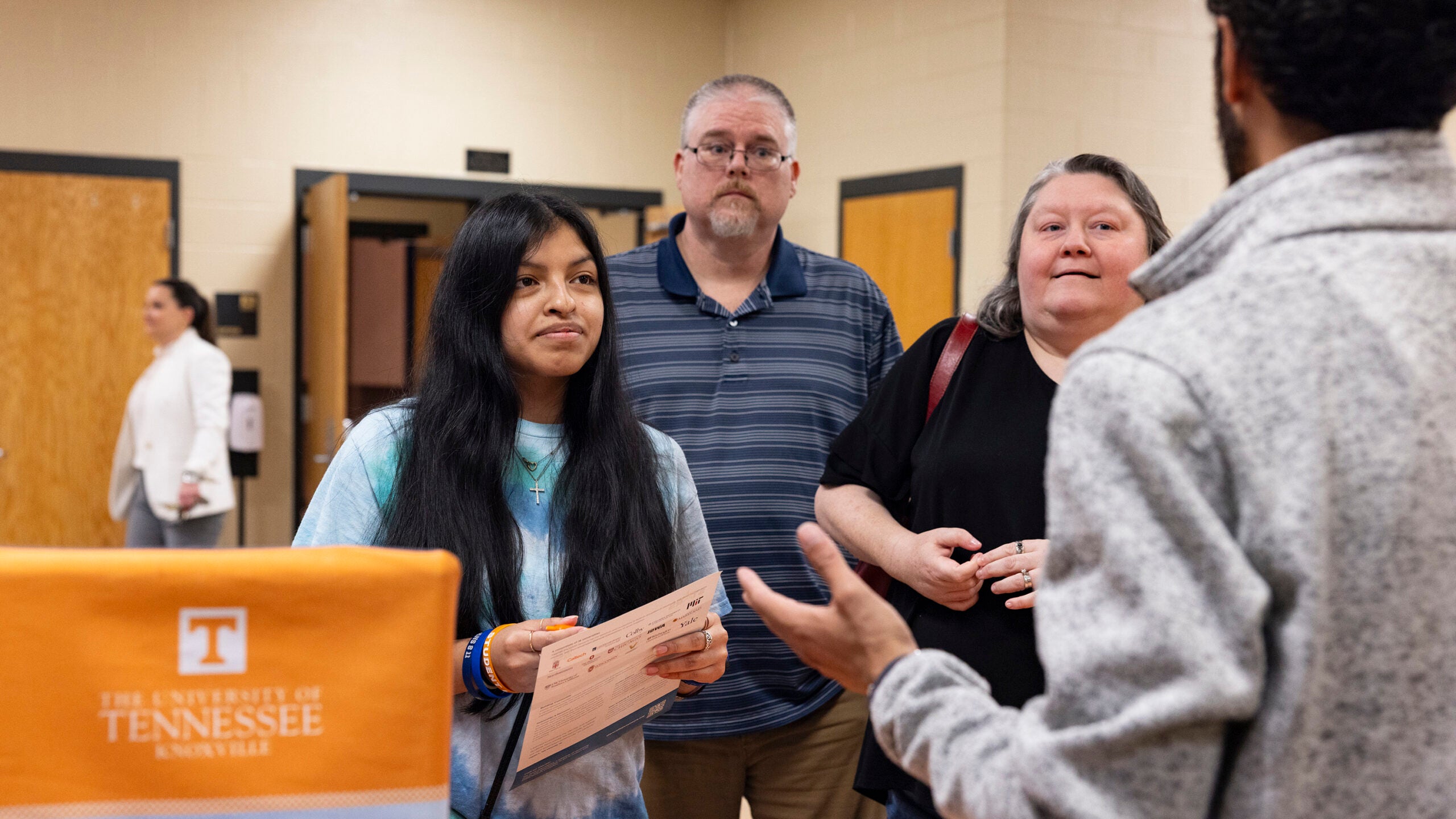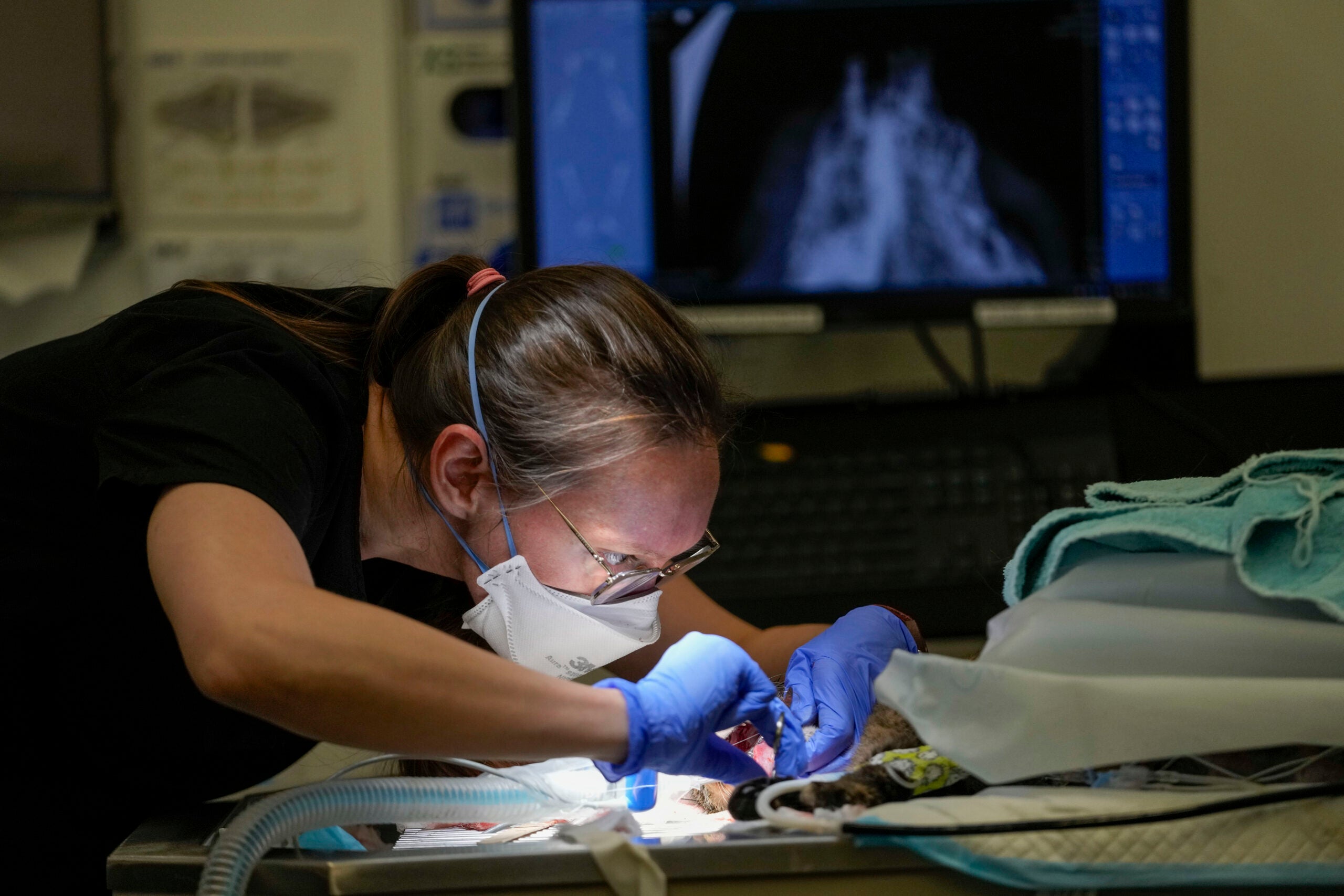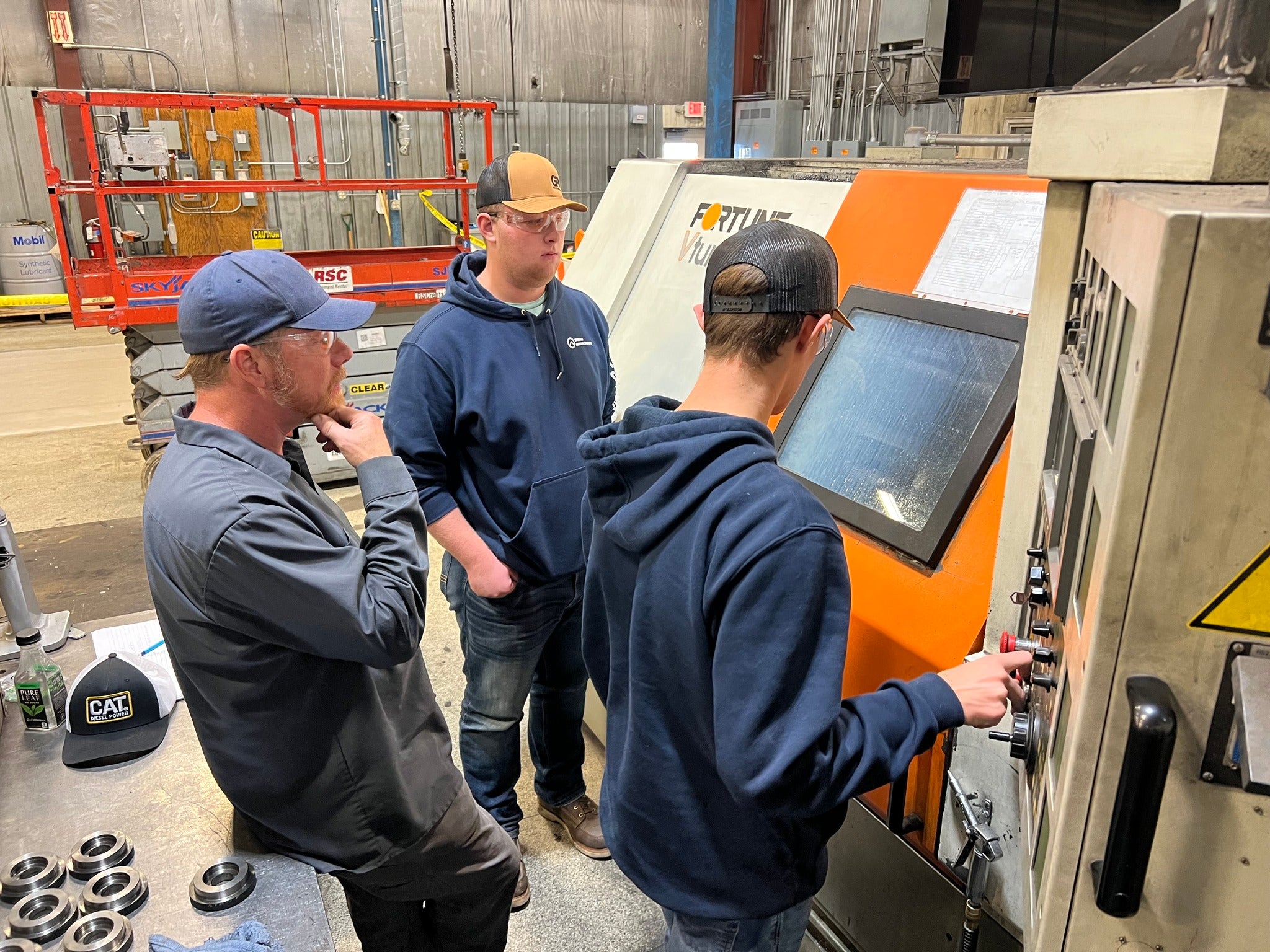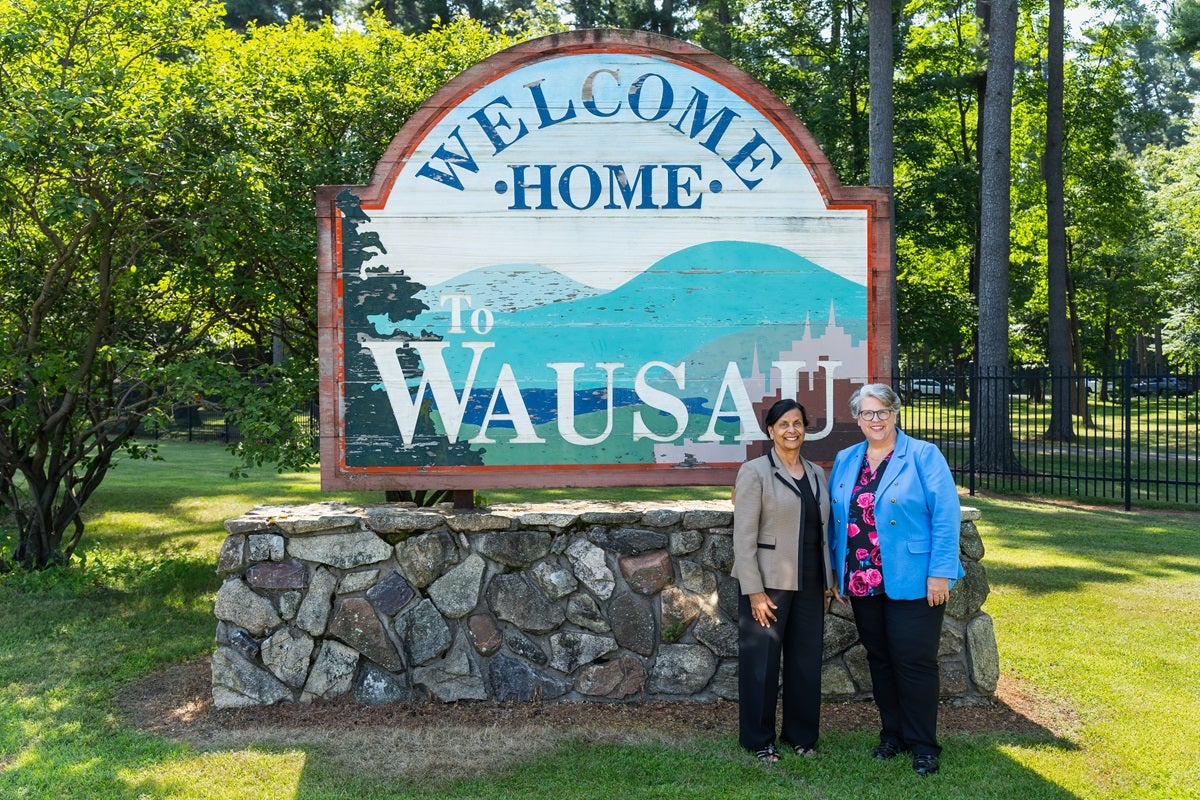Since the time she was in elementary school, Isabella Cross has dreamed of going to an Ivy League college to become an engineer.
But in Crossville, her “little no-name town” in East Tennessee, as she describes it, selective universities and colleges rarely came to recruit.
As a 17-year-old in a rural community, and the daughter of a single parent, “I always kind of felt, like, I wouldn’t say necessarily trapped, but a lot of kids feel trapped,” says Cross. “And a lot of them never get out. They never get to explore and never get to see other things.”
News with a little more humanity
WPR’s “Wisconsin Today” newsletter keeps you connected to the state you love without feeling overwhelmed. No paywall. No agenda. No corporate filter.
Now, Cross thinks applying to a top-flight college might be possible after all.
Recruiters from some of the nation’s most selective universities — MIT, the University of Chicago, Yale — have, for the first time, come to her “little no-name town.” It’s part of an effort by top schools to pay more attention to rural America, where students are less likely than their urban and suburban counterparts to go to college and, if they do, are more likely to drop out.
“It kind of just felt like they heard us, and they see us, and that they know that there’s a need as well for small-town kids like me to have really big dreams,” says Cross.
The college fair in Crossville this fall was part of a string of events throughout the state, where admissions officers from about a half-dozen of the nation’s most selective universities visited with students and parents. It was among the first by a new consortium called STARS, or Small Town and Rural Students College Network, prompted by a $20 million grant from a University of Chicago trustee.
It follows a long history of neglect of rural areas by many colleges and universities. Not even public research universities recruit in rural places, a 2019 study by scholars at UCLA and the University of Arizona found, disproportionately favoring higher-income public and private high schools in major metropolitan areas. (The study was produced for the Joyce Foundation, which financially supports NPR.)
Even when they do find their way to these small towns, recruiters are up against increasing reluctance by students and their families to go to four-year institutions, and especially to campuses far away from home.
Sixteen colleges and universities in all — also including Brown, the California Institute of Technology, Columbia, Northwestern, and the University of Southern California — have signed on to STARS and have agreed to visit rural high schools in exchange for financial help with travel costs and staffing.
“They’ve never come and taken an interest in us. But the big thing right now is rural, and they’re finally seeing it, I guess,” says Karen Hicks, lead counselor at Crossville’s Stone Memorial High School, who has been an educator in the city for 36 years. “I love it in the sense that it gives our kids opportunities. I hate that they didn’t see it before.”
Rural communities can be hard to reach, and often have only small numbers of prospective high school seniors, says Marjorie Betley, senior associate director of admissions at the University of Chicago. She helped organize the STARS project and serves as its executive director.
For recruiters, she says, “driving hours and hours on the road to meet with five students, that’s really hard.”
The new initiative comes from a University of Chicago trustee, Byron Trott, who left a small town in Missouri to attend the university, and later created a financial services company. In 2018, he asked Betley how many students at her university came from rural places, as he had.
“We couldn’t even answer the question,” Betley recalls. After further inquiry, she realized that, “the numbers were not good.”
Rural students were about 3 percent of enrollment at the time, which she says has since increased to 9 percent. Rural Americans comprise nearly 20 percent of the population, the Census Bureau reports.
Rural students graduate from high school at a higher rate (90 percent) than their counterparts in cities (82 percent) and suburbs (89 percent), according to the U.S. Department of Education. But only 55 percent go directly to college.
That’s a smaller proportion than suburban students. It’s also declining, down from 61 percent in 2016, the National Student Clearinghouse Research Center says.
So rarely do top colleges recruit in rural towns, says Bryan Sexton, a father who came with his son to the college fair in Crossville, that, “you know, when I saw some of the names, I was, like, what are these schools doing here?”
A city of 12,470 named for the spot where an old stagecoach road crossed a onetime cattle drivers’ route between Nashville and Knoxville, Crossville is a case study in how rural families aspire to, fret about, and often decide to forgo, college.
Outside the high school’s auditorium, Nae Evans Sims stopped and thought for a moment about the smallest community she’d ever visited as an admissions recruiter for Case Western Reserve University. “Oh, my gosh,” she says. “Probably this one.”
Alongside representatives from Yale, MIT, the University of Chicago, and other institutions, Sims was arranging brochures on a table in anticipation of the kind of college recruiting fair that – in more populated places – draws throngs of anxious students and their parents.
In Crossville, families from adjoining towns were also invited. In all, 81 students showed up.
“My friends in the cities, their kids start talking about college when they’re freshmen,” says Rob Harrison, a city council member who stopped by. But in Crossville, he says, “a lot of kids don’t even think about the opportunities out there. It’s just not part of the culture.”
Then again, no one from those elite universities had ever come to Crossville, local educators say, even though the graduation rate from Stone Memorial is 91 percent.
Of the students here who do continue their education, many attend the community college just across the street, where tuition is free. More than 1 in 10 enroll in a local trade school, the Tennessee College of Applied Technology, and 4 percent enlist in the military.
That makes Crossville fairly typical of rural places, where residents are less likely to get bachelor’s degrees. Only about 20 percent of people over age 25 in rural America (and 15 percent in Crossville) have bachelor’s degrees or higher, compared with 40 percent nationally, according to the U.S. Department of Agriculture. This gap, the Federal Reserve reports, has been widening steadily over the last 50 years.
That not only contributes to a worsening political and earnings divide between urban and rural America; it limits economic opportunity in rural places.
“It’s essential for rural communities to have a skilled and invested workforce,” says Noa Meyer, president of rootED Alliance, another STARS partner, which puts college and career advisors in rural high schools. “Local businesses need skilled workers.”
But the path to that goal is narrowing. At least a dozen private, nonprofit colleges in rural areas or that serve rural students have closed or announced their closings in the last three years. Public universities in rural parts of Kansas, Arkansas and West Virginia are cutting dozens of majors.
Others are merging, including in Pennsylvania and Vermont. Spending on higher education fell in 16 of the 20 most rural states between 2008 and 2018, when adjusted for inflation, according to the Center on Budget and Policy Priorities.
About 13 million people now live in higher education “deserts,” mostly in the Midwest and Great Plains, where the nearest university is beyond a reasonable commute away, the American Council on Education estimates.
“There is a significant untapped talent pool in our rural communities,” says Trott, the founder, chairman, and co-CEO of the banking company BDT & MSD Partners. “Yet rural students often lack access to the resources needed to help set them up for their education, careers, and economic stability.”
Also, as in Crossville, rural students who do go to college generally prefer to stay close to home, research shows.
“Even the ones that have the higher scores, that can survive at some of the more prestigious colleges, they like it here, and they don’t necessarily want to leave,” says Laura Kidwell, a counselor at Stone Memorial. “They want to be within driving distance from home and their family and friends and relatives.”
Aaron Conley is a senior at the school. He says he’s deciding between learning heating, ventilation and air conditioning to start his own HVAC business, or going to college to study physical therapy or nursing. Both of those fields, he notes, require “a lot of college. It’s something that I just don’t know if I want to do for a long period of time like that.”
If he does go to college, he’d opt for Tennessee Technological University in Cookeville, 30 minutes away. There, he explains, “I can come back and see my family whenever I want.”
Many parents here don’t want their kids to move away. Some worry that university campuses and faculty in far-flung places are too liberal, and not religious enough, says Hicks, the school counselor.
“Some of the things that you hear in the news and stuff that happens at different colleges is scary for a conservative family,” Hicks explains. Parents think, ” ‘I have control of you now, and I know your environment, and to send you out to that big world is scary.’ “
Amy Beth Strong says she would prefer that her daughter, Ellie Beth, stick around for at least a little while, and maybe start at the local community college after she graduates from Stone Memorial next spring.
“I’m not trying to hold on to them, and I want them to do what they want to do, but I would rather they have a little bit more life experience under their belt,” Strong says, instead of, “throwing them out in the middle of the world and saying, ‘OK, there you go. You’re 18, you’re done.’ “
Some rural parents also worry that their children, if they go far away for college, won’t come back, Hicks adds.
Some Crossville parents are encouraging their reluctant children to go on to further education, however.
Tina Carr started college, stopping now and then to earn the money she needed to pay for it. But she never graduated.
“I’ve always regretted not being able to finish,” Carr says. She’s still wearing her scrubs after commuting home from her job in Knoxville as the front-desk coordinator at a surgeon’s office. “I just see where people get stuck in – it’s a bad word to say – but ‘dead-end’ jobs without a college degree.” And while she likes what she does, “I’ve seen a lot of jobs posted throughout the years that I think I could do, but I can’t because I don’t have that degree.”
And so Carr is pushing her daughter, Kira, to continue her education: “I don’t want her down the line to eventually regret that she didn’t go to college.” Kira Carr wants to go directly into the workforce; she decided to skip the college recruiting fair.
Another major reason fewer rural high school students go to college is the cost. Median earnings in rural areas are nearly one-sixth lower than incomes elsewhere, according to the USDA.
In Crossville, the median household income is $40,708, compared with the national median of $74,580. More than 20 percent of the population lives in poverty; 40 percent of the 1,000 students at the high school are considered economically disadvantaged.
Despite their higher graduation rates, rural students often feel that they don’t belong at top colleges. That, along with homesickness and the cost, is among the reasons those who do go are more likely to drop out than their urban and suburban classmates.
“We do have rural students come in who have that imposter syndrome, with classmates who took 20 [Advanced Placement courses] and their high school didn’t have any,” says Betley, at the University of Chicago.
At the Stone Memorial recruiting fair, the longest lines were to talk to representatives from the nearby University of Tennessee at Knoxville, Middle Tennessee State University, and Tennessee Tech. The shortest line was for MIT.
“That’s typically not the MIT experience,” says Carlos Vega, the recruiter from that university. “I go somewhere and I have auditoriums full of students.”
In Tennessee, however, two other high schools that he also was supposed to visit, outside of the STARS tour, had told him not to bother coming for scheduled visits, he says, because they didn’t have any students who were interested — a first in his career.
Stone Memorial senior Ellie Beth Strong — she goes by E.B., a nickname given to her by her soccer coach — wonders how comfortable she’d feel at a big, far-off university. She says she’s applied to two Christian colleges and the University of Tennessee.
After growing up in a small town, “I don’t want to go to a giant university where I’m just another person that you pass by when you’re going to class,” she explains. “I don’t want to have 300 people in my class and have the professor just lecture the whole time. I want to actually get to sit down and talk to the people and get to know everybody.”
Many students from rural areas have similar concerns, says Corinne Smith, an associate director of admissions at Yale.
Smith is the advisor to the Rural Student Alliance at Yale, formed five years ago to help rural students feel more of a sense of belonging. When the group was started, she suggested social activities such as apple-picking. But the students instead wanted help getting used to the unaccustomed urban traffic noise outside their dorms or off-campus apartments. “Then they said, ‘Can someone take us on a tour of New Haven so I can see where things are? My town has one stoplight.’ “
Smith notes that rural perspectives like these are essential to the diversity of campuses:
“If you say you want to have a university with a wonderful political science department, and then 100 percent of the students in that political science seminar are from urban and suburban towns with the same religious and political affiliation, then are you really having the discussions that we say our institutions are meant to be having?”
Isabella Cross, the aspiring engineer, has no doubt about what she would contribute to a campus: a small-town sense of community.
In Crossville, she says, “We see you in Walmart? We’re going to stop and talk to you for 45 minutes. We’re going to ask how the kids are. We’re going to ask how your mom is doing. We’re going to ask about all of the things that, you know, sometimes you just don’t get” in big cities. “I just think that that’s something that you can bring to a school where it’s definitely a cutthroat competition to get into.”
This story was produced by The Hechinger Report, a nonprofit, independent news organization focused on inequality and innovation in education. Additional reporting by Lauren Migaki.
9(MDAyMjQ1NTA4MDEyMjU5MTk3OTdlZmMzMQ004))
© Copyright 2025 by NPR. To see more, visit https://www.npr.org.9(MDAyMjQ1NTA4MDEyMjU5MTk3OTdlZmMzMQ004))







